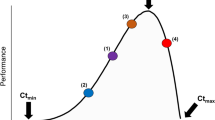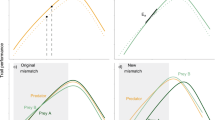Abstract
Climate warming directly influences the developmental and feeding rates of organisms. Changes in these rates are likely to have consequences for species interactions, particularly for organisms affected by stage- or size-dependent predation. However, because of differences in species-specific responses to warming, predicting the impact of warming on predator and prey densities can be difficult. We present a general model of stage-dependent predation with temperature-dependent vital rates to explore the effects of warming when predator and prey have different thermal optima. We found that warming generally favored the interactor with the higher thermal optimum. Part of this effect occurred due to the stage-dependent nature of the interaction and part due to thermal asymmetries. Interestingly, below the predator and prey thermal optima, warming caused prey densities to decline, even as increasing temperature improved prey performance. We also parameterize our model using values from a well-studied system, Arctia virginalis and Formica lasioides, in which the predator has a warmer optimum. Overall, our results provide a general framework for understanding stage- and temperature-dependent predator–prey interactions and illustrate that the thermal niche of both predator and prey is important to consider when predicting the effects of climate warming.





Similar content being viewed by others
Availability of data and material
Data is available on Zenodo at https://doi.org/10.5281/zenodo.7750483.
Code availability
Code is available on Zenodo at https://doi.org/10.5281/zenodo.7750483.
References
Abbott KC, Harmon JP, Fabina NS (2014) The challenge of predicting temperature effects on short-term predator–prey dynamics. Popul Ecol 56:375–392
Amarasekare P (2015) Effects of temperature on consumer–resource interactions. J Anim Ecol 84:665–679
Angilletta MJ (2006) Estimating and comparing thermal performance curves. J Therm Biol 31:541–545
Araújo MB, Luoto M (2007) The importance of biotic interactions for modelling species distributions under climate change. Glob Ecol Biogeogr 16:743–753
Binzer A, Guill C, Brose U, Rall BC (2012) The dynamics of food chains under climate change and nutrient enrichment. Philos Trans R Soc Lond B Biol Sci 367:2935–2944. https://doi.org/10.1098/rstb.2012.0230
Brown JH, Gillooly JF, Allen AP et al (2004) Toward a metabolic theory of ecology. Ecology 85:1771–1789. https://doi.org/10.1890/03-9000
Christensen B (1996) Predator foraging capabilities and prey antipredator behaviours : pre- versus postcapture constraints on size-dependent predator-prey interactions. Oikos 76:368–380
Culler LE, Ayres MP, Virginia RA (2015) In a warmer arctic, mosquitoes avoid increased mortality from predators by growing faster. Proc Royal Soc B Bio Sci 282. https://doi.org/10.1098/rspb.2015.1549
Daugaard U, Petchey OL, Pennekamp, (2019) Warming can destabilize predator–prey interactions by shifting the functional response from Type III to Type II. J Anim Ecol 88:1575–1586. https://doi.org/10.1111/1365-2656.13053
Davidson AT, Hamman EA, McCoy MW, Vonesh JR (2021) Asymmetrical effects of temperature on stage-structured predator-prey interactions. Funct Ecol 35:1041–1054. https://doi.org/10.1111/1365-2435.13777
de Roos AM (2021) Dynamic population stage structure due to juvenile–adult asymmetry stabilizes complex ecological communities. Proc Natl Acad Sci USA 118:e2023709118. https://doi.org/10.1073/pnas.2023709118
de Roos AM, Persson L (2002) Size-dependent life-history traits promote catastrophic collapses of top predators. PNAS 99:12907–12912. https://doi.org/10.1073/pnas.192174199
de Roos AM, Persson L (2013) Population and community ecology of ontogenetic development. Princeton University Press
Dell AI, Pawar S, Savage VM (2011) Systematic variation in the temperature dependence of physiological and ecological traits. Proc Natl Acad Sci 108:10591–10596. https://doi.org/10.1073/pnas.1015178108
Dell AI, Pawar S, Savage VM (2014) Temperature dependence of trophic interactions are driven by asymmetry of species responses and foraging strategy. J Anim Ecol 83:70–84. https://doi.org/10.1111/1365-2656.12081
Deutsch CA, Tewksbury JJ, Huey RB et al (2008) Impacts of climate warming on terrestrial ectotherms across latitude. Proc Natl Acad Sci 105:6668–6672
Dussutour A, Simpson SJ (2012) Ant workers die young and colonies collapse when fed a high-protein diet. Proc Royal Soc B Bio Sci 279:2402–2408
English-Loeb GM, Karban R, Brody AK (1990) Arctiid larvae survive attack by a tachinid parasitoid and produce viable offspring. Ecol Entomol 15:361–362
Gårdmark A, Huss M (2020) Individual variation and interactions explain food web responses to global warming. Philos Trans R Soc B Biol Sci 375:20190449. https://doi.org/10.1098/rstb.2019.0449
Gibert P, De Jong G (2001) Temperature dependence of development rate and adult size in Drosophila species: biophysical parameters: temperature parameters in Drosophila. J Evol Biol 14:267–276. https://doi.org/10.1046/j.1420-9101.2001.00272.x
Gillooly JF, Brown JH, West GB et al (2001) Effects of size and temperature on metabolic rate. Science 293:2248–2251. https://doi.org/10.1126/science.1061967
Gresens SE, Cothran ML, Thorp JH (1982) The influence of temperature on the functional response of the dragonfly Celithemis fasciata (Odonata: Libellulidae). Oecologia 53:281–284. https://doi.org/10.1007/BF00388999
Kingsolver JG (2009) The well-temperatured biologist. Am Nat 174:755–768. https://doi.org/10.1086/648310
Laws AN, Joern A (2013) Predator-prey interactions in a grassland food chain vary with temperature and food quality. Oikos 122:977–986. https://doi.org/10.1111/j.1600-0706.2012.20419.x
McCoy MW, Bolker BM, Warkentin KM, Vonesh JR (2011) Predicting predation through prey ontogeny using size-dependent functional response models. Am Nat 177:752–766
Mittelbach GG (1981) Foraging efficiency and body size : a study of optimal diet and habitat use by bluegills. Ecology 62:1370–1386
Murdoch W, Nisbet R, Blythe S et al (1987) An invulnerable age class and stability in delay-differential parasitoid-host models. Am Nat 129:263–282
Ohlund G, Hedstrom P, Norman S et al (2014) Temperature dependence of predation depends on the relative performance of predators and prey. Proc Royal Soc B Bio Sci 282:20142254–20142254. https://doi.org/10.1098/rspb.2014.2254
Paine T (1976) Size-limited predation : An observational and experimental approach with the Mytilus- isaster interaction. Ecology 57:858–873
Pepi A, Grof-Tisza P, Holyoak M, Karban R (2018) As temperature increases, predator attack rate is more important to survival than a smaller window of prey vulnerability. Ecology 99:1584–1590. https://doi.org/10.1002/ecy.2356
Pepi A, Holyoak M, Karban R (2021) Altered precipitation dynamics lead to a shift in herbivore dynamical regime. Ecol Lett 24:1400–1407. https://doi.org/10.1111/ele.13756
Pepi A, McMunn M (2021) Predator diversity and thermal niche complementarity attenuate indirect effects of warming on prey survival. Am Nat. https://doi.org/10.1086/714590
R Development Core Team (2020) R: a language and environment for statistical computing. Version 4.0.1. R Foundation for Statistical Computing, Vienna, Austria
Rosenblatt AE, Smith-Ramesh LM, Schmitz OJ (2017) Interactive effects of multiple climate change variables on food web dynamics: modeling the effects of changing temperature, CO2, and water availability on a tri-trophic food web. Food Webs 13:98–108
Rosenzweig ML, MacArthur RH (1963) Graphical representation and stability conditions of predator-prey interactions. Am Nat 97:209–223. https://doi.org/10.1086/282272
Schmitz OJ, Rosenblatt AE, Smylie M (2016) Temperature dependence of predation stress and the nutritional ecology of a generalist herbivore. Ecology 97:3119–3130
Soetaert K (2009) rootSolve: nonlinear root finding, equilibrium and steady-state analysis of ordinary differential equations. Version R-Package 1:6
Soetaert K, Herman PM (2008) A practical guide to ecological modelling: using R as a simulation platform. Springer Science & Business Media
Taylor F (1981) Ecology and evolution of physiological time in insects. Am Nat 117:1–23
Tseng M, O’Connor M (2015) Predators modify the evolutionary response of prey to temperature change. Biol Let 11:20150798
Uszko W, Diehl S, Englund G, Amarasekare P (2017) Effects of warming on predator-prey interactions - a resource-based approach and a theoretical synthesis. Ecol Lett 20:513–523. https://doi.org/10.1111/ele.12755
Vasseur DA, McCann KS (2005) A mechanistic approach for modeling temperature-dependent consumer-resource dynamics. Am Nat 166:184–198. https://doi.org/10.1086/431285
Vasseur DA, DeLong JP, Gilbert B, Greig HS, Harley CD, McCann KS, Savage V, Tunney TD, O’Connor MI (2014) Increased temperature variation poses a greater risk to species than climate warming. Proc Royal Soc B Bio Sci 281:20132612
Werner EE, Gilliam JF (1984) The ontogenetic niche and species interactions in size-structured populations. Annu Rev Ecol Syst 15:393–425
Werner EE (1986) Amphibian metamorphosis: growth rate, predation risk, and the optimal size at transformation. Am Nat 128:765–770
Funding
This work was supported by NSF-LTREB-1456225 and NIH-R35GM133439.
Author information
Authors and Affiliations
Contributions
AP conceived the project and contributed empirical data; all authors developed the model and code, wrote the manuscript, and edited the final draft.
Corresponding author
Ethics declarations
Ethics approval
Not applicable.
Consent to participate
Not applicable.
Consent for publication
Not applicable.
Competing interests
The authors declare no competing interests.
Supplementary Information
Below is the link to the electronic supplementary material.
Rights and permissions
Springer Nature or its licensor (e.g. a society or other partner) holds exclusive rights to this article under a publishing agreement with the author(s) or other rightsholder(s); author self-archiving of the accepted manuscript version of this article is solely governed by the terms of such publishing agreement and applicable law.
About this article
Cite this article
Pepi, A., Hayes, T. & Lyberger, K. Thermal asymmetries influence effects of warming on stage and size-dependent predator–prey interactions. Theor Ecol 16, 105–115 (2023). https://doi.org/10.1007/s12080-023-00555-3
Received:
Accepted:
Published:
Issue Date:
DOI: https://doi.org/10.1007/s12080-023-00555-3




